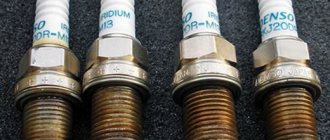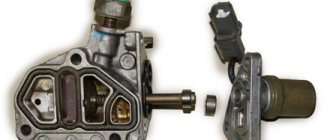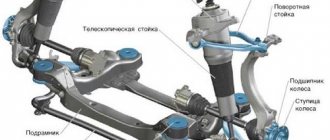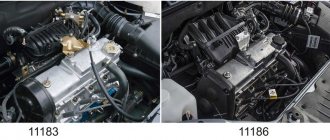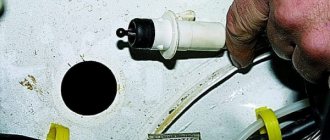In a car, the adsorber absorbs fuel vapor from the gas tank ventilation system and supplies it to the intake, because according to environmental standards, the gas tank must be isolated from the atmosphere.
From Wikipedia ;
Adsorber (from Latin ad - on, with and sorbeo - absorb) is a device for absorbing (thickening) a surface layer of a solid, called an adsorbent (absorber), of dissolved or gaseous substances, not accompanied by a chemical reaction. The adsorber is used in chemical, oil refining and other industries. The process occurring inside this apparatus is called adsorption.
Gasoline vapor filtration system. The diagram is quite conventional, but it reflects the essence. Gasoline vapor from the tank passes through a carbon filter, is cleaned and supplied to the inlet through a solenoid valve controlled by the ECU.
Now the first question is - why filter gasoline vapors if they still go into the intake? The answer is simple - adjusting the internal combustion engine control program by adding the nth number of clean air at the inlet is much easier than making adjustments based on the fuel-air mixture (gasoline vapor from the tank) of an unknown proportion.
And now the answer to the main question - why delete it? So, although some manufacturers claim that this device will have enough resources for the entire life of the car, we know that they are lying)
In general, over time, the adsorber becomes clogged and stops passing air. As a result, we get excess pressure in the tank, which interferes with the normal operation of the fuel pump. In the cabin (sometimes under the hood) we get a periodic smell of gasoline, the vapors of which are squeezed out of the ventilation tube. And the engine starts running on a rich mixture due to lack of air.
Now guess how our country solves this problem? That's right, most people simply throw out the adsorber and turn off the system as shown in the diagram:
A fuel filter from a carburetor classic is usually placed on the tube from the gas tank, and the solenoid valve, through which clean air should flow into the engine, is simply shut off with a bolt.
What is the correct name for an adsorber or absorber?
Both concepts exist in the world. But despite the fact that “sorbeo” and “absorbeo” are translated from the Latin alphabet almost identically: adsorber - (from the Latin Ad - he, with and sorbeo - absorbing) and absorber - (from the Latin absorbeo - I absorb), the semantic load of both words are different.
- In our case, it is an adsorber, since it is a device that absorbs gaseous or soluble substances onto its solid surface without undergoing chemical reactions. There are devices of periodic and continuous action.
- And an absorber is a device that completely absorbs gases (vapors) inside, followed by a chemical reaction, as a result of which one of the substances is completely absorbed by a special liquid (absorber).
Therefore, for our situation, the first option will be correct.
How does the controller monitor the operation of the injector?
When determining the specific position and opening time of the injector design, the specific volume of fuel entering the valves of the VAZ-2110 cylinder is determined. At the same time, thanks to special sensors installed on the motor, the on-board computer records specific values and transmits them to the controller.
Subsequently, the controller, based on the information coming from the on-board computer, makes a decision on the position and duration of opening of the injector damper. If the controller malfunctions, the injectors will not be adjusted correctly, and the engine may stall while driving.
Tip: when starting the engine, the injector controller operates in asynchronous mode until the engine reaches a certain number of revolutions. That is why, after replacing the silent blocks of the front control arms on a VAZ-2110, you should warm up the car for 10-15 minutes.
Purpose and principle of operation
An adsorber is a container filled with activated carbon that acts as a filter element. This element is the main part of the EVAP system - Evaporative Emission Control (gasoline vapor recovery system).
The system is integrated into the fuel system of cars of Euro-2 standard and higher. You won’t see such adsorbers on classic VAZs and even on model 2108, not to mention Moskvich, Volga 3110, etc.
The goal is to reduce harmful emissions into the atmosphere and eliminate the smell of gasoline in the car interior.
But despite the simplicity of the design, in addition to the housing and the filter element, the adsorber consists of:
- Bends: air supply, inflow, gasoline vapor removal.
- Separator: Here the vapors are condensed and discharged back into the tank.
- Gravity valve (emergency): stops fuel overflow when the machine overturns.
- The solenoid valve (or vacuum valve, for example on some Nissan models) is one of the important elements (more details below).
- Other additional devices (depending on the car model).
The fuel vapors that accumulate in the gas tank must go somewhere. In old cars they escaped into the atmosphere through a special tube. In modern cars, fuel tanks are isolated from the external environment.
Gasoline vapors enter the adsorber through a separate outlet pipe, where they condense into fuel, which is returned to the tank or intake manifold. In the first case, the process occurs with the engine turned off, in the second - with the engine running.
As soon as the car starts, the ECU sends a signal to the solenoid valve. The latter is opened and activated carbon (activated carbon) is blown out. Fuel vapors are “extracted” from the sorbent and immediately enter a special receiver and then into the combustion chamber.
To learn more about what an adsorber is, follow the link.
And now in more detail
How can I check the functionality of this device? The fundamental element in the absorber is the valve. To understand the function, let’s look at how the adsorber works. When a car is parked, a huge amount of gasoline vapor can accumulate in its tank. Some of the vapor is caught by the recuperator, and the rest settles back into the tank. The part that was caught goes into the adsorber. When the engine is running, the absorber valve closes and interrupts the access of vapors, now they are sent to the combustion chamber. What is it for? When you start the car, our device prevents vapors from entering the exhaust manifold, thereby reducing the amount of harmful substances in the gas.
In a car, the adsorber absorbs fuel vapor from the gas tank ventilation system and supplies it to the intake, because according to environmental standards, the gas tank must be isolated from the atmosphere.
From Wikipedia ;
Adsorber (from Latin ad - on, with and sorbeo - absorb) is a device for absorbing (thickening) a surface layer of a solid, called an adsorbent (absorber), of dissolved or gaseous substances, not accompanied by a chemical reaction. The adsorber is used in chemical, oil refining and other industries. The process occurring inside this apparatus is called adsorption.
Gasoline vapor filtration system. The diagram is quite conventional, but it reflects the essence. Gasoline vapor from the tank passes through a carbon filter, is cleaned and supplied to the inlet through a solenoid valve controlled by the ECU.
Now the first question is - why filter gasoline vapors if they still go into the intake? The answer is simple - adjusting the internal combustion engine control program by adding the nth number of clean air at the inlet is much easier than making adjustments based on the fuel-air mixture (gasoline vapor from the tank) of an unknown proportion.
And now the answer to the main question - why delete it? So, although some manufacturers claim that this device will have enough resources for the entire life of the car, we know that they are lying)
In general, over time, the adsorber becomes clogged and stops passing air. As a result, we get excess pressure in the tank, which interferes with the normal operation of the fuel pump. In the cabin (sometimes under the hood) we get a periodic smell of gasoline, the vapors of which are squeezed out of the ventilation tube. And the engine starts running on a rich mixture due to lack of air.
Now guess how our country solves this problem? That's right, most people simply throw out the adsorber and turn off the system as shown in the diagram: A fuel filter from a classic carburetor is usually put on the tube from the gas tank, and the solenoid valve, through which clean air should flow into the engine, is simply turned off with a bolt.
In the picture I already wrote that this is wrong and here’s why. This method of removing the adsorber only partially solves the problem. Yes, the smell of gasoline disappears, the tank is ventilated, but no air is supplied to the intake and the engine continues to run on a rich mixture.
Where is it installed?
As a rule, the adsorber is installed under the hood on the right in the direction of travel of the car, for example, in the VAZ 2110 it has the shape of a barrel.
In other cars, it may be square and installed to the left of the engine (in the direction of travel), under the air duct (Lada Granta), the vacuum brake booster (some Nissan models) or in the radiator area. In the VAZ 2114 it is located next to the battery and air filter.
On the Volkswagen Passat B3, the adsorber is located under the air filter on the right side in the direction of travel.
Other vehicles: Refer to model owner's manual.
Where is the adsorber located on the VAZ 2110?
In order to find the adsorber, you need to lift the hood and look in the near left corner, there you will see a small black cylindrical jar.
Replacing the VAZ 2110 adsorber is a simple procedure; it consists of buying a new adsorber, removing the old one and connecting all the hoses in accordance with how they were connected.
That's all for me, the article about the adsorber has come to an end, whoever liked it, comment and share the article on social networks using the special buttons at the bottom of the article. Thank you for your attention, see you again at VAZ Repair.
Why do they refuse the adsorber?
Despite the advantages of this design solution, and these are: fuel economy, absence of odor in the cabin, reduction of harmful emissions into the atmosphere (although many do not care about this), the adsorber has a number of significant drawbacks, because of which many seek to close it or completely remove it.
Disadvantages, they are also signs of malfunction:
- High cost of the product (not for all cars). Replace or remove? More often they prefer the second option. For example, on an Acura MDX the price of a product fluctuates around 10,000 rubles. For VAZ - from 800 rubles.
- A malfunction of the device leads to interruptions in the operation of the unit: the engine does not pull (poor acceleration of the car, damping of lifting, transportation of goods, floating idle speed on a hot engine, if the tank is plastic, then the adsorber is clogged, constantly compresses and opens (in the absence of a bypass valve in the lid ), as a result, it can burst from the pressure of gasoline vapors, if it is metal, it is deformed. Malfunction of the adsorber Hissing when opening the fuel tank cap, caused by the movement of air in the tank (not out) and the smell of gasoline in the cabin, incorrect fuel level. The appearance of error p0443 (cause of malfunction) error - clogged or faulty solenoid valve).
So when a product fails, many people turn it off and remove it, or take the more difficult route of opening the case and replacing the old activated carbon with a new one.
Replacing the canister purge valve
How to change:
- Move the latch stopper upward.
- Disconnect the block with wires from the valve by pressing the latch.
- Disconnect the connection tube with the intake manifold by pressing the spring clips.
- Similarly, we disconnect the connection tube with the adsorber from the valve branch pipe.
- Remove the adsorber valve from the bracket.
Installation of the canister purge valve is carried out in the reverse order.
How to disable or remove the adsorber on a car and do you need to reflash the ECU?
It should be understood that when removing the adsorber, the solenoid valve is turned off, which is connected directly to the controller and is controlled by the latter.
This will result in error p0443, which we already mentioned above. The pipes are also plugged, especially the one that goes to the intake manifold.
What is the disadvantage of such a shutdown?
The fact is that air is constantly drawn in through the pipe going into the intake manifold; even in idle mode, the so-called small purge of the adsorber occurs. At high speeds from 1500 to 2000 and above, a large leak occurs.
The ECU firmware takes into account constant air leaks and fuel vapor consumption during the formation of the air-fuel mixture, despite the fact that all this comes from the mass air flow sensor, the causes of the malfunction of which can be found by clicking on the link.
If you plug the hose, which many people do, a certain amount of air will not get into the intake manifold bypassing the ECU, but the ECU will still take this into account.
That is, the controller takes into account one volume of air, but actually another (smaller) one enters. As a result, the amount of fuel produced by the engine control unit is based on more air than is supplied. This leads to an enrichment of the air-fuel mixture.
As a result, the engine does not perform properly because the mixture is constantly richer in places where it is and is not needed, and fuel consumption increases.
It is also worth talking about the transient mode of engine operation, which can occur when approaching an intersection, a traffic light, a lying policeman, or the moment the gas comes out.
At this moment, a malfunction may occur - a decrease in speed below the minimum. The engine seems to be choking, there is not enough air, the reason is that the mixture is too rich. In a few seconds the situation will be resolved electronically.
Therefore, disabling the adsorber will be correct in the following ways:
- After removing the device, install a nozzle with a diameter of 1 mm in the pipe passing directly in front of the flow meter. This will at least partially solve the problem, since only air without gasoline vapors will be dosed.
- The ECU flashes (difficult). If the test error cannot be resolved, the motor chip may need to be reconfigured, which is expensive.
- Disassembling the entire system with the exception of the solenoid valve, which is at a minimum.
- By installing a resistor (valve emulation) in the electrical circuit of 200 - 250 Ohms and 2 W. To do this, bend the legs of the resistor and insert it into the valve chip. We secure everything with electrical tape. But this doesn't always help.
How to disable the adsorber on a VAZ 2110, 2112, 2114
Taking into account the above recommendations, we do the following:
- Disconnect the power connector from the valve.
- Disconnect all hoses from the adsorber and remove the adsorber along with the caliper.
- We fix the valve in a place where you can reach the plug with wires and pipes.
- Connect a hose with a fuel filter to the lower fitting (see Photo below).
- At the end of the upper fitting: connect the pipe going to the intake manifold.
- On the pipe going to the tank, we place another filter, similar to the first.
With this scheme, when the valve opens, clean air enters the system, albeit without gasoline vapors.
We exclude the valve
This method is even simpler. We disassemble everything, including the valve. We put a fuel filter on the pipe coming from the gas tank, and we dampen the pipe going to the intake manifold with a bolt and clamp.
The consequences of this method are described above, but this method also has a right to life.
As for Priora, Granta, Lada Largus, Gazelle and other cars, turning off the shock absorber is similar to that described above.
Toyota Chaser
It is worth considering one of the foreign cars, for example Toyota Chaser.
The shutdown principle is similar to the previous ones:
- Find the cylinder valve. It is located next to the mass air flow sensor on the air filter housing.
- Disconnect the microcircuit with wires and all hoses from it (the controls on the instrument panel may turn on).
- Find the adsorber, disconnect the pipes from it and connect.
- Disconnect the pipe going to the valve from the throttle assembly and connect it with a bolt to the clamp.
- We put the fuel filter from the VAZ carburetor onto the pipe leading to the tank.
What's the catch in flashing from Euro 4 to Euro 2?
Many people ask for ECUs from Euro-4 to Euro-2; as a rule, this is done when removing the catalyst and installing the mixture. At this point, the adsorption valve may be turned off (intentionally or accidentally), and the ECU does not control the latter and does not control it in any way.
As a result, if the valve fails, the engine will run rough and the error will not be displayed on the instrument cluster. To verify this, close the valve and watch the engine operate.
If the version is confirmed, plug the canister pipes and close the valve; the controller still does not control it.
The canister valve is knocking, clicking or clicking
We make sure that the noise comes specifically from the adsorber valve, and not from the timing belt, rollers and other elements. To do this, simply press the gas pedal sharply. If the chattering noise does not change, then the source of the noise is the adsorber valve. It is not uncommon for the clatter of the adsorber valve to appear only in cold weather at sub-zero temperatures.
What can you do about it?:
1. Contact an authorized dealer with the problem. If the adsorber valve is truly faulty, it will be replaced under warranty. If they consider that such valve operation is the norm, then there is no point in writing in support of AVTOVAZ.
2. Advice from car enthusiasts (you lose your warranty!). There is an adjusting screw on the side of the valve, which is filled with glue. Remove the glue and turn the screw clockwise 90 degrees. After this, the adsorber valve no longer clicks in the cold.
3. Owners of LADA cars advise spraying silicone grease into the adsorber hole:
If you decide to buy a canister purge valve, then look for it by article number:
- 82 00 248 821 (for Lada Vesta or XRAY).
- 11180-1164200-00, 11180-1164200-01 (for Lada Granta/Kalina)
- 21103-1164200-01, 21103-1164200-02 or 21103-1164200-03 (for Lada Priora and Niva 4x4)
- 8200692605 (for Lada Largus)
Have you encountered problems with the adsorber valve?
Keywords: sound insulation lada xray | sound insulation of Lada Vesta | sound insulation of Lada Largus | soundproofing of Lada Granta | sound insulation of Lada Kalina | sound insulation of Lada Priora | soundproofing 4x4 | lada xray sensors | Lada Vesta sensors | Lada Largus sensors | Lada Granta sensors | Lada Kalina sensors | Lada Priora sensors | 4x4 sensors | ECM Lada Vesta | ECM Lada XRAY | ECM Lada Largus | ECM Lada Granta | ECM Lada Kalina | ECM Lada Priora | ECM 4x4 | soundproofing Niva | Niva sensors | esud niva | universal article
0 0 0 0 0 1
Share on social networks:

